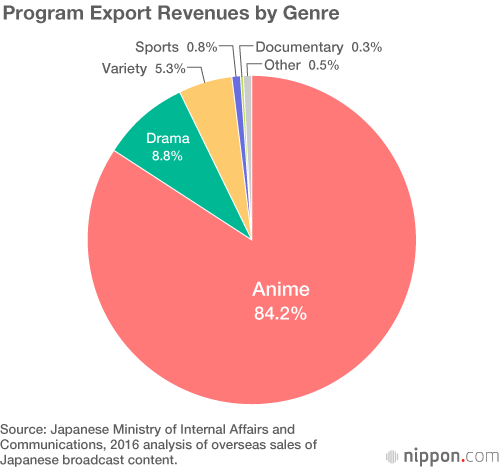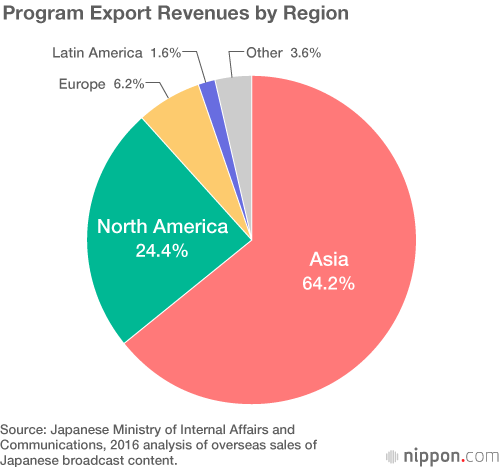
Japanese Television’s Contribution to Tourism
Economy Society- English
- 日本語
- 简体字
- 繁體字
- Français
- Español
- العربية
- Русский
Japan welcomed over 28 million foreign tourists in 2017, a more than three-fold increase since 2010 when approximately 8 million people from overseas visited. One of the many conceivable factors contributing to this rapid growth is the increase in sales of Japanese television programs overseas. Revenues from overseas sales of Japanese broadcast content totaled some ¥6.6 billion in 2010, a figure which grew to ¥39.4 billion by 2016. It is not difficult to imagine that overseas audiences have become interested in Japan as a result of watching programs which showcase Japanese culture and lifestyles, and thus have been visiting Japan in ever greater numbers.

According to a Ministry of Internal Affairs and Communications report analyzing overseas sales of Japanese broadcast content in 2016, anime accounted for 80% of sales of marketing rights, which covers over-the-air broadcasts, online distribution, and videocassettes and DVDs. Dramas and variety shows accounted for most of the remaining 20%. A major reason for this discrepancy in sales is that while the ability to understand Japanese presents a barrier to overseas viewers watching live-action dramas, anime as a market segment is capable of transcending this obstacle. The report also shows that primary overseas markets for Japanese broadcast content are in Asia and North America. What follows is a discussion of the characteristics of the various media segments.


The Potential of Anime
Japanese animation first achieved global recognition in the 1980s. At the time state-owned television channels in Europe were privatizing and cable and satellite TV were also starting up in earnest, resulting in a worldwide scramble for programming to fill the expanding airwaves. Buyers were lining up to do business with distributors capable of supplying inexpensive content in large quantities, with American television dramas and Japanese animation being the focus of particularly intense interest.
While European elites treated such large inflows of content as cultural imperialism, Japanese producers were in fact motivated to sell their wares overseas not by a desire to impose their culture on others but by a sense of internationalism. This influx of Japanese anime created a generation of European fans who came of age watching such content. Subsequently, they have been the driving force behind Japanese pop culture events across the continent, the best known of these being Japan Expo, which takes place in July in Paris.
The advantage anime has as an industry is that there exists an established scheme for dividing labor between publishers who work on formatting and development based on manga or prose novels and television stations and movie studios that produce the animated version of works. Entertaining stories are essential to making enticing motion pictures, and associations with the publishing industry in Japan result in a supply of high-quality source material that gets turned into broadly appealing content.
The rapid proliferation of online distribution services (some have even called it a bubble) has resulted in recent years in another worldwide content shortage in recent years. As the potential of the Japanese animation industry to supply desirable products is still strong, inquiries about anime are once again pouring in from all over the world. Online distribution vendors in China and Netflix in the United States are particularly proactive in this regard.
Anime as a media segment has potential for growth in many ways. As well as the existing business of providing video material, it is also an intellectual property hotbed. In addition to conventional merchandising in toys, foods, and stationery items, events such as anime song festivals are now being convened.
So-called pilgrimages, involving visits to locations which appear in anime, are another such activity, known in the United States and Europe as content tourism. It is common for Japanese anime to feature actual places for story locations, providing part of the motivation for tourists to want to visit Japan.
New business developments are emerging as well, such as a project conceived by the Japanese Anime Tourism Association in which members of BNK48, a popular pop idol group in Thailand, visit various anime locations across Japan and introduce viewers to local goods and places of interest. The project is a collaboration between Thai TV stations that broadcast the programs and the Japanese production companies and stations that produce them.
Remade for Global Consumption
In 2017, two dramas by Japanese broadcaster NTV, Mother that aired in 2010 and Woman that aired in 2013, were much talked about in overseas marketing circles. The reason was that Turkish remakes, called Anne and Kadin, mother and women respectively in Turkish, had become hits, giving rise to additional market developments.
Anne has to date been shown in over 20 countries, including Mexico, Chile, Croatia, and Serbia, while TV stations all over the world are similarly making offers for Kadin. The fact that a Turkish remake of a Japanese TV drama became a worldwide hit is noteworthy as it means that sales of remake rights of dramas and other programs are now a viable option for overseas business on par with selling complete product packages. But it goes without saying that to succeed in the remake rights market, the original drama has to have an entertaining story and characters that are endearing in their own right.
Thus far, Japanese marketers have sold complete product packages chiefly in Asia. Japanese TV dramas from the 1990s through the 2000s have been particularly popular in China, significantly driving the increase in Chinese exchange students and tourists. Taiwan and South Korea are other leading markets for Japanese TV dramas.
Local Stations Helping Promote Tourism
Another media segment on a par with drama remake rights sales in terms of activity is the export of the variety show format. The TBS series Sasuke Ninja Warrior is one very successful examples of this formula. The show, which features contestants who must clear a progressively difficult set of obstacles, has aired in 165 countries and regions worldwide to date and has been particularly popular in the United States, Taiwan, and Malaysia.
Along with TBS, other anchor network affiliate stations, in Tokyo and Osaka in particular, also show variety-information programs that are very well-regarded internationally. In partnerships with influential local production houses and agencies, these stations produce these programs, which are localized for their particular regions, end-to-end, from overall format through to specific segments. These programs are in turn sold by the partner firms to the local stations which air them. The entire market has made further advances beyond mere program sales as well, with some stations also investing in the local production houses, playing the role of international collaborators, as well as founding local firms in such places as Taiwan and Singapore.
In the present decade, numerous infotainment programs have been aired in Japan that might collectively be referred to as “walking tours.” In these shows, comedians and other entertainers walk down the streets of a town, stopping to eat at shops and visit businesses in the neighborhood. When these shows are sold to overseas broadcasters, viewers are able to enjoy genuine information about sightseeing destinations and cuisine from all over Japan, motivating people to visit. The intentions of a number of disparate groups come together to make this a lively media segment for overseas business that includes local governments who want to get the word out about their towns, TV stations facing production budget cuts, and talent agencies who want to promote their clients.
Television stations in Hokkaidō have been successfully involved in this media segment since the 1990s. They have produced content that has drawn tourists from tropical and subtropical regions as well as from the Southern Hemisphere, many of whom are fascinated by the wintertime climate and diet of the northern island, providing struggling regional economies a welcomed boost. Likewise, television stations in Kyūshū have made programs showcasing well-known hot spring locales like Yufuin and Beppu. Stations in the Tōkai and Hokuriku regions as well have been partnering to make shows about prime tourist spots along the extensive Shōryūdō sightseeing excursion route that spans central Japan.
Programs that showcase local ramen specialties are also popular overseas. Although the noodle dish is to be found everywhere in Japan, specific ingredients and flavors vary by region, and these shows highlight the distinctive characteristics, leading to a visible increase in foreign tourists at ramen shops across the country.
Television shows based on such topics as tourism, traditional culture, and foods like sweets, seafood, and haute and common cuisine are being made and broadcast overseas through collaborations among various TV stations regardless of network affiliation. These programs carry a tremendous amount of information. There is simply no comparison in this regard between now and the previous decade, when Japan was ranked only about thirtieth by international tourist volume and hardly anyone had heard of any places in Japan besides Tokyo and Kyoto.
(Originally published in Japanese on July 9, 2018. Banner photo: © Pixta.)